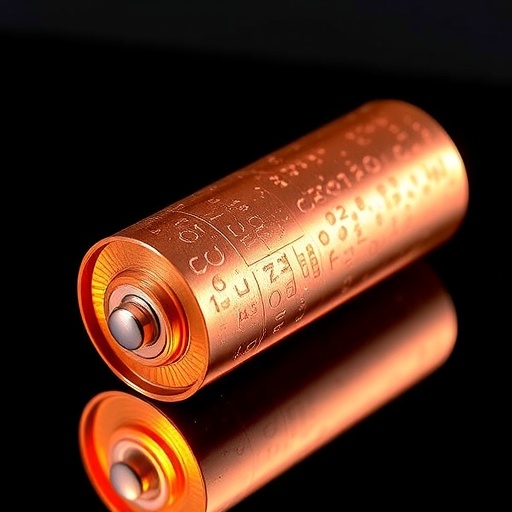In the quest for sustainable energy storage solutions, sodium-ion batteries (SIBs) are drawing significant attention as an alternative to the lithium-ion battery systems that currently dominate the market. This is largely due to sodium’s abundance and low cost, which positions it as an attractive alternative especially in the context of increasing lithium extraction challenges. However, for sodium-ion technology to reach its full potential, breakthroughs in electrode materials are essential. A recent study published in the journal Ionics introduces a promising new cathode material: K-rich potassium copper hexacyanoferrate (KCuHCF).
This innovative material offers several advantages, including exceptional electrochemical stability, which is a critical characteristic for any battery technology aimed at real-world applications. The research conducted by Lv, Li, Liu, and their colleagues highlights how this K-rich compound can not only enhance the performance of SIBs but also provide a reliable framework that can withstand the rigorous demands of repeated charge and discharge cycles. The structural integrity of the KCuHCF compound is a significant factor contributing to its sustainability and longevity as a cathode material.
Delving deeper into the composition of KCuHCF, one finds that its synthesis incorporates potassium ions alongside copper and hexacyanoferrate components, resulting in a compound that holds considerable promise for sodium-ion applications. The researchers employed advanced characterization techniques to understand the material’s crystal structure and electronic properties. What emerged was a cathode that showcases superior ionic diffusion pathways, allowing for effective sodium ion transport during the charging and discharging processes.
The electrochemical profiling revealed that KCuHCF maintains an impressive capacity retention during cycling, a hallmark of effective cathode materials. When subjected to various charge/discharge conditions, the K-rich compound demonstrated resilience, showing minimal degradation and high coulombic efficiency over extended periods. These quantitative findings are vital as they point to a path forward where sodium-ion technologies can achieve a competitive edge against lithium-ion alternatives.
One of the significant challenges that SIBs face is the selection of suitable cathode materials that can provide both stability and capacity. This ongoing research actively addresses these barriers, aiming to optimize performance metrics through material engineering. With the inclusion of potassium in its structure, the KCuHCF not only contributes to enhanced electrical performance but also promotes a more environmentally benign battery technology—an essential aspect in contemporary battery research.
Moreover, the thermal stability exhibited by KCuHCF is another key feature that positions it as a game-changer in the battery landscape. High-performance batteries require materials that can withstand various thermal stresses without compromising safety or performance. The researchers report that KCuHCF shows a high decomposition temperature, which could minimize the risk of thermal runaway—an issue that has plagued many conventional battery technologies.
In terms of practical applications, sodium-ion batteries utilizing K-rich potassium copper hexacyanoferrate could serve many diverse sectors, including renewable energy systems, electric vehicles, and portable electronics. The transition towards sodium-based systems aligns with broader environmental goals, promoting sustainability and reducing reliance on finite resources.
The findings of this study not only reinforce the potential of sodium-ion batteries but also open the door to advanced research into alternative cathode materials. As the scientific community increasingly recognizes the importance of diverse material sets for energy storage, KCuHCF stands at the forefront of this movement. This study may prompt further exploration of hexacyanoferrate compounds or even other innovative materials that could enhance the performance of SIBs.
In summary, the introduction of K-rich potassium copper hexacyanoferrate as a stable cathode material marks an important milestone in the evolution of sodium-ion battery technology. Its blend of structural integrity, superior electrochemical stability, and environmental benefits positions it as a frontrunner in the drive towards sustainable energy solutions. Future studies will undoubtedly build upon these findings, refining the performance characteristics of this promising material while expanding the horizons of sodium-ion battery applications.
As the global community grapples with finding efficient and cost-effective storage solutions for renewable energy, innovations such as KCuHCF will play a pivotal role in shaping the future of energy. The research community’s drive toward refining sodium-ion technologies is gaining momentum, with potential widespread implications across various industries. The advent of this new cathode material is not merely an academic exercise; it holds real promise for tackling some of the most pressing energy storage challenges of our time.
The implications of this research extend beyond mere energy storage; they touch upon the broader themes of resource utilization and sustainability in the face of increasing energy demands worldwide. By prioritizing materials that are not only high-performing but also abundant, researchers can contribute to a more secure energy future.
The work of Lv, Li, Liu, and their colleagues represents a critical step forward in this endeavor—one that will surely inspire ongoing innovation in the field of battery technology as we move towards a bolder, more sustainable energy horizon.
Subject of Research: Sodium-ion batteries and K-rich potassium copper hexacyanoferrate as a cathode material.
Article Title: K-rich potassium copper hexacyanoferrate as a stable cathode material for sodium-ion batteries.
Article References:
Lv, HT., Li, YY., Liu, Q. et al. K-rich potassium copper hexacyanoferrate as a stable cathode material for sodium-ion batteries. Ionics (2025). https://doi.org/10.1007/s11581-025-06736-w
Image Credits: AI Generated
DOI: https://doi.org/10.1007/s11581-025-06736-w
Keywords: sodium-ion batteries, cathode materials, K-rich potassium copper hexacyanoferrate, electrochemical stability, sustainable energy storage.
Tags: electrochemical stability in batterieselectrode materials for SIBsK-rich copper hexacyanoferrate cathodelithium-ion battery alternativeslongevity of battery cathodesperformance enhancement in sodium-ion batteriespotassium copper hexacyanoferrate synthesisrenewable energy storage innovationssodium-ion batteries advantagessodium-ion battery technologystructural integrity in battery materialssustainable energy storage solutions





